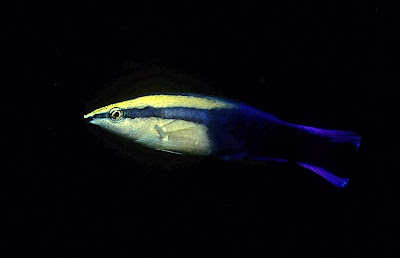 This is an enlarged photo of a little bitty fish --but he's a little fish with a big, important job. Meet the Hawaiian Cleaner Wrasse (Labroides phthirophagus).
This is an enlarged photo of a little bitty fish --but he's a little fish with a big, important job. Meet the Hawaiian Cleaner Wrasse (Labroides phthirophagus).These little fellows -- only two to four inches long as adults -- make their living by keeping other fish clean. They are an important part of the reef community.
The little cleaner wrasse stakes out a spot on the reef, usually near a prominent coral head. He hovers above the coral in a head-up posture and wiggles. That's the cleaner wrasse equivalent of turning on a neon sign that says "OPEN."
Other fish come as clients to the cleaning station to be rid of bits of old scales, dead skin, and small parasites that they may have acquired. The client fish swims up to the cleaner wrasse and stops. The cleaner wrasse approaches and gives his client a once over, looking all for extraneous bits, which he then pecks off. This service can take anywhere from a moment, to several minutes, depending on how big the client is -- and how scruffy!
BNSullivan558x360.jpg) Here's a photo of a Hawaiian Cleaner Wrasse servicing a Spotted Puffer (Arothron meleagris) at Puako. [And yes -- in case you were wondering -- the Spotted Puffer is a first cousin to the Stripebelly Puffer that we showed you a number of weeks ago. They belong to the same genus.]
Here's a photo of a Hawaiian Cleaner Wrasse servicing a Spotted Puffer (Arothron meleagris) at Puako. [And yes -- in case you were wondering -- the Spotted Puffer is a first cousin to the Stripebelly Puffer that we showed you a number of weeks ago. They belong to the same genus.]These cleaning stations serve pelagic (open ocean) fish as well as reef fish. It's not unusual to see animals like sharks, manta rays, and large jacks waiting their turn at busy cleaning stations.
Once a cleaning station is established, it will exist for a long time -- even for years -- in the same spot. Client fish learn where it is, and return to it again and again. The busier cleaning stations may have several cleaners at work -- much like a barber shop with multiple chairs.
Some fish that don't clean other fish full time, do become cleaners from time to time. An example that comes quickly to mind are the several species of fish that clean turtles here in Hawaii. It happens that turtles' carapaces sometimes get covered with a film of algae. Certain fish that are primarily algae-eaters will clean the turtles' shells -- not because they are trying to clean them but because they like to eat the algae, regardless of whether it's growing on a rock, on a coral head, or on the back of a turtle.
Several species of shrimp also make their living cleaning other animals on the reef, and they act as dental hygienists as well. It's not at all uncommon to see a toothsome moray eel -- jaws agape -- with a little cleaner shrimp busily pecking about inside the eel's mouth. (Moray eels don't floss!)
We've played with both the cleaner wrasse and the shrimp to see if we could get them to work on us. The wrasses rarely seemed very interested in us, save for occasionally snipping at Jerry's whiskers. The cleaner shrimp are another story entirely. They'll readily crawl around on our hands, pecking at our cuticles, for example. And by the way, that REALLY tickles!
The cleaner wrasse in the photos on this page is endemic to the Hawaiian Islands. That is, it is native to our waters and exists naturally only here. But, it has close relatives in other parts of the world that look very similar, and which serve the same function in their own locales.

BNSullivan.jpg)
BNSullivan.jpg)
BNSullivan.jpg)
BNSullivan.jpg)
BNSullivan.jpg)
BNSullivan.jpg)



This is exciting. I wonder how the fish know to come to them cleaning?
ReplyDeleteSuch a fascinating intuitive world.
Thanks I am trying to work on some metaphors to use in my keynotes from your narratives.
Please think about submitting articles to http:www.articlesforbooomers.com
This is great material the world should know about
Hey there ideacoach,
ReplyDeleteCleaning stations are usually designated by large coral heads along the reef with an abundance of juvenile fish swimming about. And yes, fish do watch others to see where the cleanings take place. What is really amazing is the unwritten rules of cleaning stations among fish.
Predators such as barracuda or grouper will not attack the cleaning fish. This symbiotic relationship parallels that of the anemone and clownfish of the Pacific.
Also, it is very easy for divers to take photographs of fish from these cleaning stations as they feel very safe and will not move away as quickly as they would while grazing along the reef.
Well said, Christopher. Thanks for adding your comments to the story. ;-}
ReplyDeleteBobbie
great story, bobbie! everybody enjoys your underwater photography plus we always learn something new about those creatures.
ReplyDeletehave you ever tried writing a book with your diving stories? think about it. would be very rewarding, more than writing the blog with limited readership to bloggers who know about your great work. aloha, pua
Great shots and info Bobbie, they are not only lovely but usefull as well,thanks for sharing.
ReplyDeleteHi Pua - I'm glad you like the stories. It makes them worth writing. No, I have no intention of turning The Right Blue into a book -- at least not at this time. Later on, who knows? But thanks so much for the compliments.
ReplyDeleteBobbie
Bernie, thank you very much.
ReplyDeleteBobbie
I love visiting...I always learn something new!
ReplyDeleteHi Neva - And we love to have you visit! :-D
ReplyDeleteBobbie & Jerry